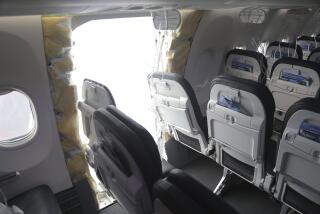Clinton Orders Safety Review of Space Shuttle
WASHINGTON — With the space shuttle program being cut sharply while the National Aeronautics and Space Administration is preparing for its critical role in building an international space station, President Clinton on Friday ordered a comprehensive review of shuttle safety.
In a letter directing NASA Administrator Daniel S. Goldin to conduct the review, White House officials warned that rapid management changes in the shuttle program may “inadvertently create unacceptable risks to safety.”
Senior White House staff members insisted that the review was not prompted by the perception of an imminent safety problem--even though several high-level NASA managers have left the agency in the past year after protesting that safety margins are eroding.
Experts inside and outside the space agency are growing increasingly worried that sharp budget cuts and rapid management changes are jeopardizing the safety of the space shuttle just as it faces its most difficult task--helping assemble the $30-billion international space station. The station will require about two dozen shuttle flights, as well as 50 flights by other nations.
White House science officials said the safety review is warranted by the profound changes NASA has been making in the shuttle program, without an examination of whether all the individual reforms will have a collective impact on safety.
“This is not the result of any persons saying they are concerned, but it is time to do a comprehensive assessment,” said a White House official.
The review will be conducted by the Aerospace Advisory Safety Panel, a committee of outside experts that has been issuing reports over the past year that raise a number of concerns about safety problems. Among its findings are that the shuttle’s navigation and landing equipment is obsolete and that plans to upgrade the system are being delayed to save money.
The panel is expected to begin the review next month and issue a report to the White House in November, about one year before the shuttle will make its first trip to work on the space station.
Goldin, the NASA chief, has insisted in recent interviews that the shuttle remains safe, though he has acknowledged that he was not told of deficiencies on the fleet of orbiters. In March, Goldin ordered his own review of shuttle safety equipment.
A number of industry and government space experts have questioned whether NASA’s working bureaucracy, heavily influenced by former military officers, has walled off Goldin.
NASA has chopped the space shuttle work force from 35,400 four years ago to 26,000 today and plans to ax 5,000 more jobs, pushing the cutback to 41%.
NASA is also turning over a share of its duties to a joint venture of Rockwell International Corp. and Lockheed Martin Corp.
Reversing reforms enacted in the aftermath of the Challenger shuttle explosion a decade ago, NASA is also reorganizing its management to transfer responsibility for the shuttle program from Washington headquarters to Johnson Space Center in Houston.
The rapid changes have prompted at least three senior managers to leave the program. Bryan O’Connor left his post as director of the space shuttle program this year after he failed to persuade Goldin to abort plans to transfer shuttle management to Johnson Space Center.
Jeremiah Pearson, the former associate administrator for human spaceflight, quit the agency last year over concern that the personnel cutbacks were too rapid.
Charles T. Force, associate administrator for space communications, left protesting that the management reforms would weaken the agency’s technical capabilities.
Some independent space experts said the review will put a needed spotlight on what they charged is the dangerous course that NASA and Congress are following by sharply cutting the agency’s budget.
“It is a well-founded fear on the part of the White House that the thing is going to blow up,” said John Pike, a space expert at the Federation of American Scientists.
More to Read
Sign up for Essential California
The most important California stories and recommendations in your inbox every morning.
You may occasionally receive promotional content from the Los Angeles Times.










